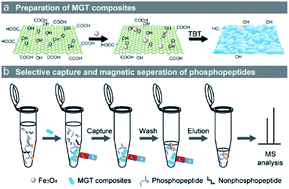Preparation of magnetic graphene composites with hierarchical structure for selective capture of phosphopeptides†
Abstract
A novel graphene composite affinity material consisting of graphene scaffolds, Fe3O4 nanoparticles for actuation and fully covered porous titania nanostructures as affinity coating has been designed and constructed. The obtained magnetic graphene composites have a saturation magnetization (Ms) value of 7.3 emu g−1, a BET specific surface area of 111.8 m2 g−1 and an average pore size of 15.1 nm for the porous affinity coating. The multifunctional graphene composites can realize the selective capture and convenient magnetic separation of target phosphopeptides by taking advantage of the decorated magnetic nanoparticles, highly pure and well crystallized affinity coating, and unique porous structure. The sensitivity and selectivity of the affinity graphene composites were evaluated using digests of standard proteins and complex biosamples as well as by comparison with the widely used TiO2 affinity microspheres. The results show that the affinity graphene composites can realize selective capture and rapid separation of low-abundant phosphopeptides from complex biological samples. Thus, this work will contribute to future applications in the purification and separation of specific biomolecules, in particular low-abundant phosphopeptide biomarkers.


 Please wait while we load your content...
Please wait while we load your content...